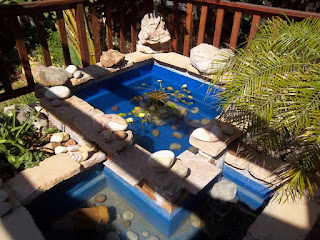The digger / loader had previously cleared all the renosterbos from the area, and we got John, our part-time helper to dig us a couple of holes. The locals have devised a way of digging holes in that hard ground which is amazing. They thump the ground with a pointed metal pole (I don't know what it is called, but it is available at our local Co-Op) and every so often they scoop the loosened sand / rock out with a can. Defies belief, but it works, and works better than a pickax!
I say a couple - well, actually, 15 holes LOL
Then we laid down a row of weedguard.
 |
| Preparing the site for more lemon trees |
 |
| I'm very grateful for the strength in RMan's hands and arms |
 |
| Porous pipe ready to be installed on the timed irrigation hose |
With the size of the diameter of the circle we have allowed for growing space for the lemon tree trunk. Also, bear in mind that the porous pipe will supply water to the ground for a distance of 500mm to either side of it. So I anticipate good coverage of the future tree root system.
 |
| The rocks are there as support for the young lemon sapling, and to close the X we made in the weedguard in order to plant the trees |
 |
| You can see the outline of the porous pipe below the weedguard |
 |
| The trees we planted last year are in the foreground - the latest trees are in the background |
 |
| Hard to believe the trees next to the closest shadecloth were only planted last January. You can also see the position to which we have moved the caravan. |
 |
| The new section in the orchard - 15 more trees to add to the 15 which were planted last year. |
 |
| 1st orchard on the left - new orchard on the right |
 |
| From left - the smallest lemon saplings, slightly bigger in the centre, and the sturdier new ones on the very right/ |
This is what happened...
 |
| A whole pot of trees waiting to be set free |
Looks like I'm going to be busy...
And, Mr H, thanks for the tip. I have also dropped two different types of apple pips into a pot of soil. They are also popping their heads above ground. I guess I'm going to have to find a spot for them too :)
In addition to all the veggies, I will also have a pomegranate, grape, lemon, apple and naartjie (mandarin), strawberry, raspberry and gooseberry harvest at some stage in the future. It surely can't get much better than that!
I am so very grateful for all of this. The future harvests, the opportunity of being able to become more self-sufficient, and for the wonderful, exciting, exhausting and the mentally, spiritually and physically enriching journey that RMan and I are on, even if it is at an advanced stage in our lives. I guess you could say that we are living proof of never being too old to try something new.
And, happily, one of the most important reasons for our purchasing our smallholding and travelling along our eco-friendly path (and documenting it, firstly, on my web page, and, secondly, through this blog) has culminated in an absolutely wonderful result and action. Beyond my wildest dreams :) I have big news to share with you - but not yet...
And, finally, this photo is to give you an idea of the "growing" area on the farm - as it now stands.
And, that is what we have accomplished in our garden in the past year... Reckon the next year could be even more interesting :) I'm so impatient I can barely handle the wait... (you gather that I am not a patient person - so I've learnt that too! LOL)




.JPG)
.JPG)
.JPG)




































